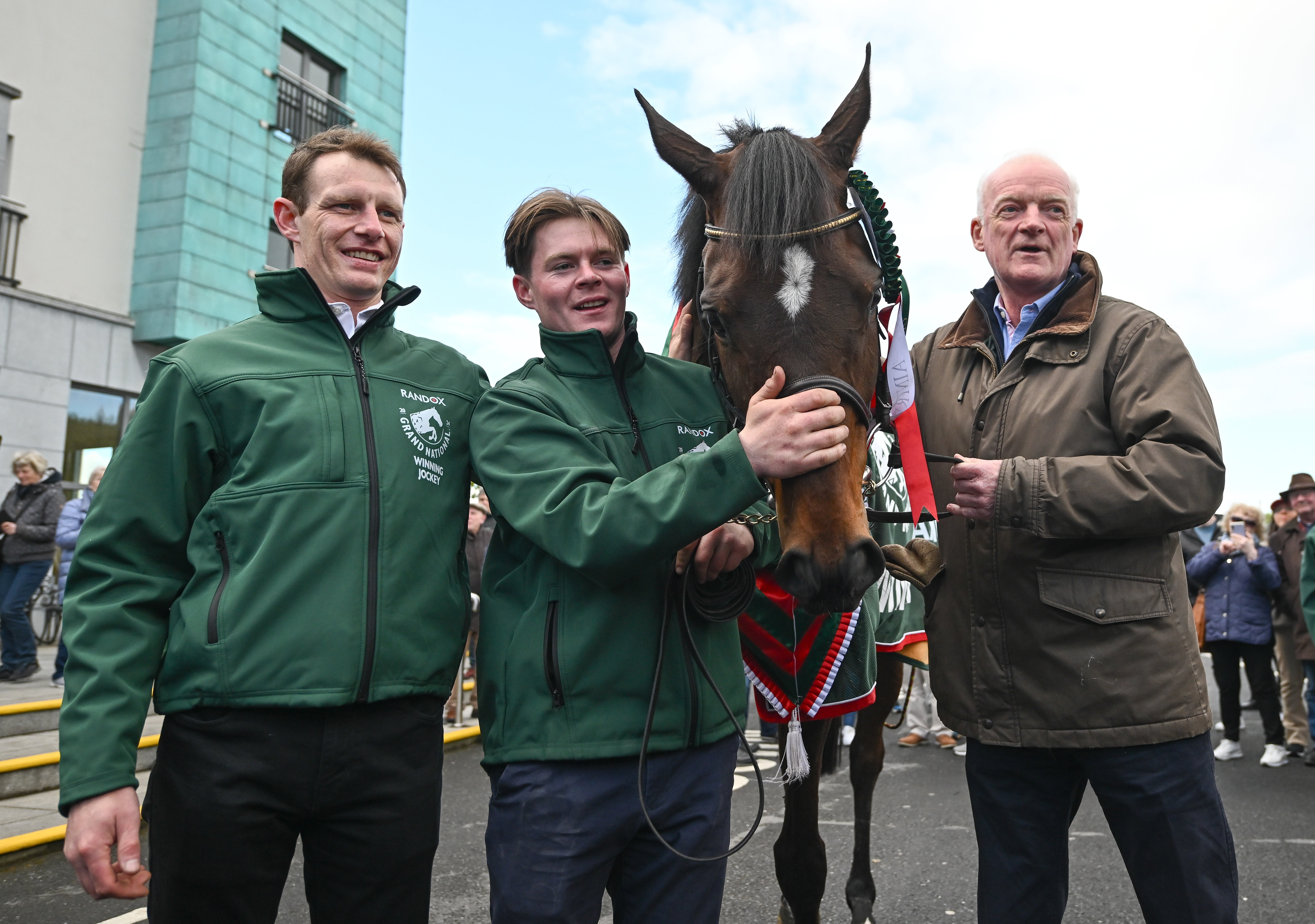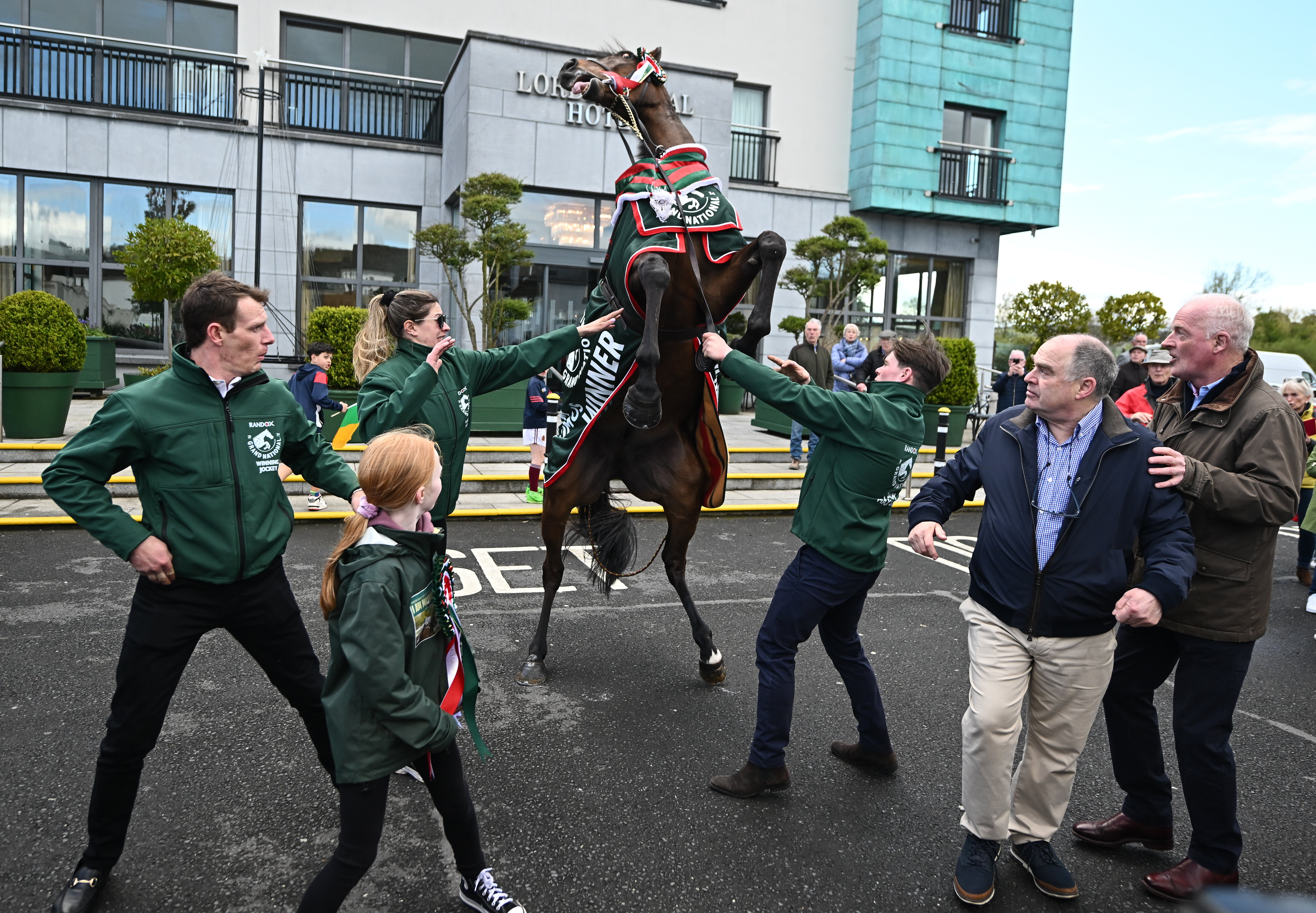Horseplay on Victory Parade
This is the hair-raising moment I Am Maximus went out of control in front of hundreds of fans as the Grand National winner revelled in his homecoming parade. The exuberant eight-year-old flung himself onto his hind legs as Willie Mullins and Co took him on a victory walk through the village of Leighlinbridge in Co Carlow, Ireland.
Tense Moment
But the tense moment he reared he was caught on camera in a spectacular photo. Fortunately, his two handlers quickly brought him back under control and the festivities continued.
Future Plans
I Am Maximus' £500,000 National win has launched Mullins to the top of the British champion trainers' league. Mullins is now eyeing the Gold Cup for I Am Maximus and is set to take on Galopin Des Champs in next year's race.
Special Season
Mullins shared his excitement about the future, saying, "I Am Maximus is in great shape. He's bounced out of the race very well. We'll train him like a Gold Cup horse now. It's been an incredible season and Saturday was very, very special."

Frequently Asked Questions
How are horses and their riders kept safe during a racing event?
The safety of both horses and riders is of paramount importance in UK horse racing. Racecourses must meet strict safety standards. This includes the condition of tracks and the quality or the jumps. Horses must be examined before and immediately after races. The jockeys wear protective equipment like body protectors or helmets. The sport also employs veterinarians and rapid response teams to handle any incident quickly and competently.
Do different horse races take place in the UK?
There are several types of horse race in the UK. These include Flat racing, National Hunt racing (or jump racing), and other races. Flat racing is held over flat tracks that range from 5 furlongs up to 2 miles. National Hunt racing places emphasis on the horse’s speed and ability to jump, and races such as hurdles and steeplechases feature a number of obstacles. There are variations within these two broad categories such as handicaps and maidens races. Each has its own entry criteria and rules.
What does the term “stayer”, used in racing, mean?
In racing terms, a ‘stayer’ is a horse that excels in racing over long distances. These distances typically exceed a mile and four-furlongs. Stayers require not only speed, but endurance as well to maintain their pace during long races. Renowned stayers compete in long distance races like the Ascot Gold Cup.
What is the significance and history of the jockey silks?
The jockey’s silks are the colorful and patterned garments worn during a race. Each set is unique to its owner and allows both spectators as well as officials to easily identify each horse during the race. Owners can choose to include colors, patterns and emblems that have sentimental or traditional value.
What are the ‘Classics” in UK horseracing?
Classics in UK Horse Racing refers a series five prestigious races, which are traditionally regarded as the most prestigious competitions for three-year old thoroughbreds. These are The 2,000 Guineas, The 1,000 Guineas, The Epsom Derby, The Epsom Oaks, and The St. Leger Stakes. This is a major achievement for any horse. Winning the Triple Crown is even more impressive.
How do racehorses get bred for racing and how are they selected?
Racehorses tend to be bred for the purpose of winning races. Breeders carefully select sires from proven racing lines to ensure that their offspring have the best characteristics in terms of speed, endurance, temperament, and so on. Thoroughbreds, which are the most common breeds associated with racing in Britain, are closely tracked. Prospective racehorses often go through a selection process that includes pedigree analysis, physical conformation assessments, and performance in training before they begin their racing careers.
Statistics
- The National Hunt racing season in the UK sees approximately 1,000 races with hurdles or fences each year.
- The Grand National at Aintree boasts a prize fund of around £1 million, making it the most valuable jump race in Europe.
- In the UK, more than 14,000 people are employed directly in the horse racing industry.
- British racing oversees around 1,500 fixtures annually across its 59 racecourses.
- British horse racing generates over £350 million in annual tax revenues for the UK government.
- Around 14,000 thoroughbred foals are born each year in the UK with the goal of becoming top racehorses.
External Links
betfair.com
thejockeyclub.co.uk
thejockeyclub.co.uk
britishhorseracingmuseum.org.uk
britishhorseracing.com
timeform.com
How To
How to Prepare For A Jockey Career In The UK
Aspiring British jockeys can begin their education at the British Racing School (or Northern Racing College) where they will learn about horse care, riding and fitness. After completing the foundation course, aspiring jockeys should enroll in an apprenticeship program or conditional training to gain experience. Maintaining the right weight and maintaining physical fitness are important. A license is required by the British Horseracing Authority for potential jockeys. This includes practical tests and exams about racing rules. Career development for jockeys is based on continuous professional growth and personal fitness regimens.

